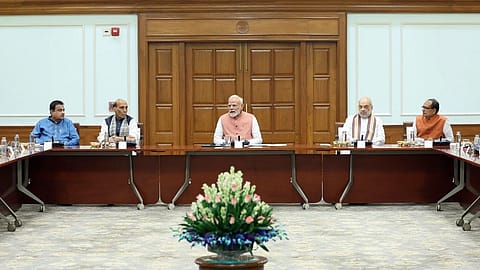PM Modi attends high-level meeting, charts roadmap for next-gen reforms to boost ease of living and business
Prime Minister Modi's high-level meeting focused on next-gen reforms to improve ease of living and business, with a spotlight on GST changes. The reforms aim to simplify tax rates and enhance compliance, especially for small enterprises.

Prime Minister Narendra Modi today chaired a high-level meeting to deliberate on the roadmap for next-generation reforms, which will enhance the ease of living, improve the ease of doing business, and foster inclusive prosperity.
In a post on X, the Prime Minister said: “Chaired a meeting to discuss the roadmap for Next-Generation Reforms. We are committed to speedy reforms across all sectors, which will boost Ease of Living, Ease of Doing Business and prosperity.”
Union ministers Rajnath Singh, Amit Shah, Nitin Gadkari, Nirmala Sitharaman, Shivraj Singh Chouhan, Piyush Goyal and Lalan Singh attended the high-level meeting.
The Prime Minister's comments come two days after Independence Day on August 15, when he announced the formation of a task force for "next-generation reforms" and the revision of GST laws, terming it as a "Diwali gift" to the common man.
Calling it a measure that has benefitted the common man, farmers, the middle class and MSMEs, the Prime Minister said the next generation of reforms under GST will be critical in advancing the goal of an Atmanirbhar Bharat.
Following the official announcement by PM Modi, the Finance Ministry released a detailed circular on the reformation of the Goods and Services Tax (GST), one of the most significant economic reforms since 2017.
“Key areas identified for next-generation reforms include the rationalisation of tax rates to benefit all sections of society, especially the common man, women, students, middle class, and farmers. Reforms will also seek to reduce classification-related disputes, correcting inverted duty structures in specific sectors, ensuring greater rate stability, and further enhancing ease of doing business. These measures would strengthen key economic sectors, stimulate economic activity, and enable sectoral expansion,” the Finance Ministry said.
Recommended Stories
The Centre has now sent a detailed proposal to the Group of Ministers (GoM) constituted by the GST Council, outlining a reform package anchored on three pillars—structural reforms, rate rationalisation, and ease of living.
The Centre has proposed rationalisation of tax slabs to simplify the structure into two key rates, standard and merit, with special rates reserved only for select items. This would replace the existing multiple-slab system, making compliance more straightforward. Lowering taxes on common-use goods and aspirational products has also been identified as a way to improve affordability and boost consumption. Further, with the end of the compensation cess, fiscal space has opened up, offering flexibility to align rates sustainably under the GST framework.
The reforms also target improving ease of compliance, particularly for small businesses and startups. Key measures include seamless, technology-driven and time-bound registration processes, the rollout of pre-filled returns to reduce manual intervention, and faster, automated refunds for exporters and those affected by inverted duty structures. These steps aim to cut down delays, reduce mismatches, and strengthen trust in the system.
The Centre has said it will work in close coordination with the states to build consensus on the proposed measures, in line with the spirit of cooperative federalism. The GST Council, in its upcoming meetings, is expected to deliberate on the GoM’s recommendations. The government has indicated its intent to facilitate early implementation so that the benefits can be realised within the current financial year.
(INR CR)